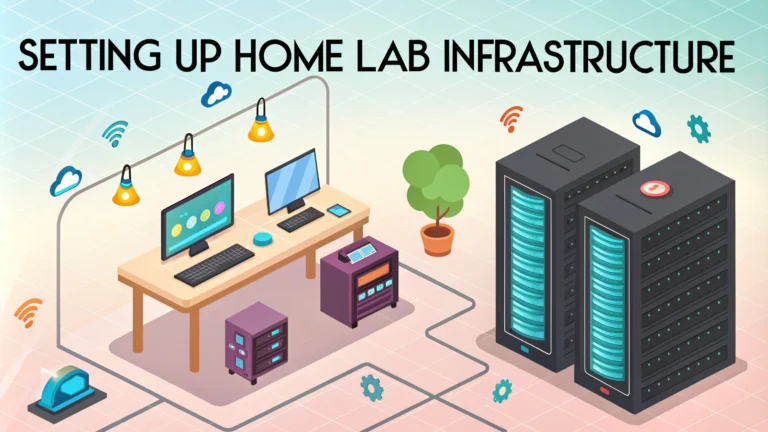Building a home lab for penetration testing gives security professionals and enthusiasts a safe, controlled environment to practice offensive security techniques.
A well-designed home lab allows you to explore vulnerabilities, test exploits, and improve your penetration testing skills without legal risks.
This guide walks through the essential components and setup process for creating an effective penetration testing lab environment.
Required Hardware Components
- A dedicated computer/server with minimum 16GB RAM and multi-core processor
- Network switch (managed preferred)
- Router with VLAN support
- Ethernet cables
- Optional: Additional computers/devices for target systems
Virtualization Platform Setup
VMware Workstation Pro or VirtualBox serve as excellent foundations for running multiple virtual machines.
- VMware Workstation Pro ($249 – recommended for professionals)
- VirtualBox (Free – good for beginners)
- Proxmox VE (Free – advanced users)
Essential Virtual Machines
- Kali Linux (attack platform)
- Metasploitable (intentionally vulnerable Linux)
- Windows Server (target practice)
- DVWA (Damn Vulnerable Web Application)
- Ubuntu Server (network services)
Network Configuration
Create isolated networks using VLANs or separate virtual network segments.
| Network Type | Purpose |
|---|---|
| Management Network | Lab administration |
| Attack Network | Offensive security tools |
| Target Network | Vulnerable systems |
Security Considerations
- Never connect lab networks to production environments
- Use strong passwords for all systems
- Implement network segmentation
- Regular backups of configurations
- Monitor resource usage
Recommended Tools
- Network Analysis: Wireshark, tcpdump
- Vulnerability Scanning: Nessus, OpenVAS
- Web Testing: Burp Suite, OWASP ZAP
- Exploitation: Metasploit Framework
Documentation and Learning Resources
- Offensive Security – Training and certification
- VulnHub – Vulnerable VM downloads
- HackTheBox – Online penetration testing labs
Setting Up for Success
Document all configurations and maintain regular snapshots of your virtual machines.
Start with basic scenarios and gradually increase complexity as your skills improve.
Join online communities like /r/homelab and /r/netsec for support and guidance.
Lab Maintenance and Updates
- Schedule regular system updates
- Clean up unused VMs and resources
- Monitor disk space and performance
- Keep a change log of modifications
- Test backups periodically
Advanced Lab Enhancements
Active Directory Integration
- Deploy Windows Domain Controller
- Configure user policies and groups
- Practice domain-based attacks
Network Monitoring
- Security Onion deployment
- IDS/IPS implementation
- Log aggregation systems
Automation and Scripting
- Ansible for configuration management
- Python scripts for lab setup
- Automated vulnerability assessment
- Custom attack scenarios
Common Troubleshooting
| Issue | Solution |
|---|---|
| Resource exhaustion | Adjust VM resources, close unused systems |
| Network connectivity | Check VLAN configs, virtual switches |
| Performance issues | Monitor host resources, optimize VMs |
Building Your Testing Methodology
Develop a systematic approach to penetration testing using your lab environment:
- Reconnaissance and scanning
- Vulnerability assessment
- Exploitation techniques
- Post-exploitation practice
- Documentation and reporting
Future-Proofing Your Security Lab
Stay current with emerging threats and defensive measures by regularly updating your lab environment and skills.
Consider expanding your lab with cloud-based resources and containerization for more diverse testing scenarios.
Remember that a well-maintained penetration testing lab is an invaluable asset for continuous learning and professional development in cybersecurity.
FAQs
- What basic hardware requirements do I need for a home penetration testing lab?
A computer with at least 16GB RAM, quad-core processor, 500GB storage, and virtualization support (VT-x/AMD-V) is recommended for running multiple virtual machines efficiently. - Which hypervisor should I use for my home lab?
Oracle VirtualBox or VMware Workstation are ideal for beginners. VMware ESXi or Proxmox are better for advanced users needing enterprise-level features and better resource management. - What operating systems should I include in my pentesting lab?
Kali Linux as the attack platform, Windows 10/11, Windows Server, Ubuntu Server, and Metasploitable for vulnerable targets. Having multiple versions creates a diverse testing environment. - How should I set up networking in my virtual lab environment?
Create isolated virtual networks using NAT or Host-only networking to prevent lab systems from accessing external networks. Use separate network segments for attack and target machines. - What security measures should I implement when setting up a home lab?
Never connect vulnerable machines directly to the internet, use strong passwords, implement network segmentation, and regularly backup your configurations and data. - Which vulnerability scanning tools should I install in my lab?
Nmap for network scanning, OpenVAS for vulnerability assessment, Wireshark for packet analysis, and Metasploit Framework for exploitation testing are essential tools. - How can I practice web application security testing in my lab?
Install vulnerable web applications like DVWA, WebGoat, and Juice Shop. Set up LAMP/XAMPP servers to host custom web applications for testing. - What documentation should I maintain for my home lab?
Keep detailed records of network configurations, IP addresses, installed software versions, and test cases. Document all successful attacks and mitigation strategies. - How can I ensure my lab environment doesn’t affect my personal network?
Use dedicated network interfaces or VLANs, implement strict firewall rules, and regularly monitor network traffic for any suspicious activities. - What are some recommended vulnerable machines for practice?
Metasploitable 2/3, vulnhub VMs, HackTheBox machines, and purposely vulnerable Windows machines with outdated software for practicing common exploits.







